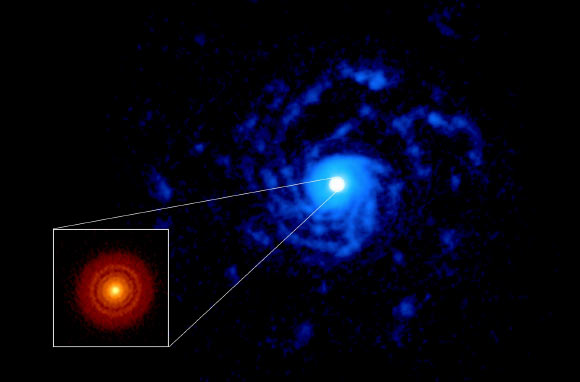Astronomers using the Atacama Large Millimeter/submillimeter Array (ALMA) have discovered a giant set of spiral arms around the young variable star RU Lupi. The spiral structure, made of carbon monoxide gas, extends to nearly 1,000 AU (astronomical units) from the star, much farther away than the compact dust disk that extends to about 60 AU.

This ALMA image shows the planet-forming disk around the young star RU Lupi. The inset image (lower left, red disk) shows the DSHARP observation of the dust disk with rings and gaps that hint at the presence of forming planets. The new observation shows a large spiral structure (blue), made out of gas, that spans far beyond the compact dust disk. Image credit: ALMA / ESO / NAOJ / NRAO / J. Huang and S. Andrews / AUI / NSF / S. Dagnello.
RU Lupi, also known as RU Lup, HD 142560 and HIC 78094, is located approximately 400 light-years away in the constellation of Lupus.
The star is 0.7 times the mass of the Sun and 1.6 times the Sun’s radius and is surrounded by a protoplanetary disk.
Previous observations of the star with ALMA, which were part of the Disk Substructures at High Angular Resolution Project (DSHARP), already revealed signs of ongoing planet formation, hinted by the dust gaps in the disk.
“But we also noticed some faint carbon monoxide structures that extended beyond the disk,” said Dr. Jane Huang, an astronomer at the Harvard & Smithsonian Center for Astrophysics.
“That’s why we decided to observe the disk around the star again, this time focusing on the gas instead of the dust.”
Protoplanetary disks contain much more gas than dust. While dust is needed to accumulate the cores of planets, gas creates their atmospheres.
In recent years, high resolution observations of dust structures have revolutionized our understanding of planet formation.
However, the new ALMA image of the gas around RU Lupi indicates that the current view of planet formation is still too simplistic and that it might be much more chaotic than previously inferred from the well-known images of neatly concentric ringed disks.
“The fact that we observed this spiral structure in the gas after a longer observation suggests that we have likely not seen the full diversity and complexity of planet-forming environments,” Dr. Huang said.
“We may have missed much of the gas structures in other disks.”
Dr. Huang and colleagues suggest several scenarios that could possibly explain why the spiral arms appeared around RU Lupi.
Maybe the disk is collapsing under its own gravity, because it is so massive. Or maybe RU Lupi is interacting with another star.
Another possibility is that the disk is interacting with its environment, accreting interstellar material along the spiral arms.
“None of these scenarios completely explain what we have observed,” said Dr. Sean Andrews, also from the Harvard & Smithsonian Center for Astrophysics.
“There might be unknown processes happening during planet formation that we have not yet accounted for in our models.”
“We will only learn what they are if we find other disks out there that look like RU Lupi.”
The team’s paper was published in the Astrophysical Journal.
_____
Jane Huang et al. 2020. Large-scale CO Spiral Arms and Complex Kinematics Associated with the T Tauri Star RU Lup. ApJ 898, 140; doi: 10.3847/1538-4357/aba1e1







